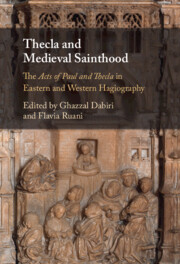Book contents
- Thecla and Medieval Sainthood
- Thecla and Medieval Sainthood
- Copyright page
- Contents
- Contributors
- Acknowledgments
- Abbreviations
- Introduction
- Part I An Act to Follow
- Chapter 1 A Cainite Invocation of Thecla?
- Chapter 2 Saint Thecla in Geʿez Hagiographical Literature
- Chapter 3 Versified Martyrs
- Chapter 4 The Reception of the Acts of Thecla in Armenia
- Chapter 5 Thecla beyond Thecla
- Chapter 6 Shifting the Poetics of Gender Ambiguity
- Part II An Act to Surpass
- Afterword
- Appendix Summaries of Texts
- Index
- References
Chapter 6 - Shifting the Poetics of Gender Ambiguity
The Coptic Naturalization of Thecla
from Part I - An Act to Follow
Published online by Cambridge University Press: 06 May 2022
- Thecla and Medieval Sainthood
- Thecla and Medieval Sainthood
- Copyright page
- Contents
- Contributors
- Acknowledgments
- Abbreviations
- Introduction
- Part I An Act to Follow
- Chapter 1 A Cainite Invocation of Thecla?
- Chapter 2 Saint Thecla in Geʿez Hagiographical Literature
- Chapter 3 Versified Martyrs
- Chapter 4 The Reception of the Acts of Thecla in Armenia
- Chapter 5 Thecla beyond Thecla
- Chapter 6 Shifting the Poetics of Gender Ambiguity
- Part II An Act to Surpass
- Afterword
- Appendix Summaries of Texts
- Index
- References
Summary
The figure of Thecla knew very early success in Egypt as a model for female ascetics and pilgrims. In learned Alexandrian circles, Thecla was also a literary rallying point for rich women who cultivated an intellectual persona. The association of the character with the blurring of gender categories was also made in the same circles and eventually spread to the equivalent circles in Valley cities. One of the most interesting literary texts in that respect is built around characters called Thecla and Paul, but not explicitly the ones from the APT, and adding a third, Egyptian character called Paese, whom it sets up as the central figure. This seventh- or eighth-century text, entitled the Martyrdom of Paese and Thecla, plays on several motifs of the APT, subverting them and reversing roles and characters, but it also borrows motifs of male companionship from the late sixth- and early seventh-century ascetic literature produced in the area between Palestine, Cyprus, and Alexandria.
Keywords
- Type
- Chapter
- Information
- Thecla and Medieval Sainthood<I>The Acts of Paul and Thecla</I> in Eastern and Western Hagiography, pp. 175 - 194Publisher: Cambridge University PressPrint publication year: 2022



